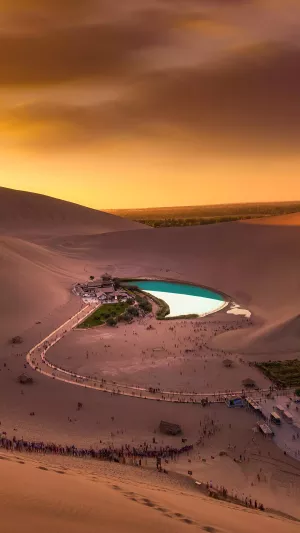China is a vast country with an area of 9.6 million square kilometres, boasting a plethora of beautiful mountains, rivers, and other natural landscapes.
One such renowned scenic spot in Dunhuang, China, is Crescent Spring. Crescent Spring spans more than 100 meters from north to south and about 25 meters from east to west. Its curved shape, reminiscent of a crescent moon, inspired its beautiful name.
Nestled in the arms of the desert for over 2,000 years, Crescent Spring has long fascinated people. Many wonder how this spring, surrounded by arid desert, manages to retain water year-round without drying up. Historically, the Crescent Spring’s water source has been linked to the Danghe River, an ancient river west of the spring. Originating in the Qilian Mountains, the Danghe River is considered the mother river of the Dunhuang people. The river’s water supply primarily depends on the melting snow and ice from the Qilian Mountains.
Significant amounts of river water seep into the ground, transforming into groundwater. In the past, the Crescent Spring and the Danghe River were connected through underground channels. The sand layer at the bottom of Crescent Spring is very soft, so when the Danghe River's water level rises, it ensures the spring’s water level remains stable.
Dunhuang, as a critical node on the Silk Road and a meeting point of Eastern and Western civilizations, has its own historical glory. Today, it remains a place people yearn to visit. Among Dunhuang’s many beautiful natural landscapes, Crescent Spring stands out as a top attraction.
Before the advent of the Internet, Crescent Spring was already a famous tourist destination in China. It drew countless visitors each year, contributing significantly to its revenue and fame. The spring’s popularity is partly due to its unique location and natural environment—a water landscape in the middle of a desert, which many find quite magical. However, despite its enchanting appearance, the state of Crescent Spring has faced challenges.
Being one of the few beautiful natural scenes in the desert, Crescent Spring’s significance is immense. In 1994, it was recognized as a national key scenic area and was honoured as one of the “five most beautiful deserts in China.” Over time, however, the spring began to dry up, prompting a sense of crisis among authorities.
To preserve this desert wonder and address the declining water levels, authorities took immediate action. They invested substantial resources into manually transporting water to Crescent Spring from distant locations to replenish it. Over the past 18 years, more than $4 billion has been spent to keep the landscape alive. Despite these efforts, the long-term sustainability of Crescent Spring remains uncertain.
The ongoing efforts to maintain Crescent Spring highlight the challenges of preserving natural landscapes in harsh environments. The authorities' dedication to maintaining this iconic site reflects its importance not only as a tourist attraction but also as a symbol of natural beauty and historical significance. The future of Crescent Spring depends on continued conservation efforts and innovative solutions to sustain its water levels in the face of environmental changes.
Ultimately, Crescent Spring serves as a reminder of the delicate balance between nature and human intervention. It underscores the need for sustainable practices to protect such unique natural wonders.





